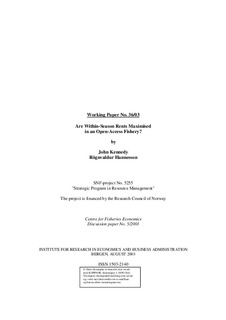Are within-season rents maximised in an open-access fishery?
Working paper

View/
Date
2003-08Metadata
Show full item recordCollections
- Working papers (SNF) [809]
Abstract
It is often assumed that zero rents are generated in an open-access fishery. There are many justifications for this, such as the existence of intraseasonal and interseasonal stock externalities, and entry and exit of vessels dependent on positive and negative rents. It is important to consider under what conditions the assumption applies, because these determine the benefits of different types of regulation, and the way in which open-access conditions are modelled. Some of the conditions which determine whether within-season rents are maximised under open-access are examined for the simple condition under which all inputs of the fisher are variable. Fishers are modelled as non-cooperative decision makers. It is shown that depending on how the fisher’s problem is formulated, there may be no dissipation of within-season rents, no matter what the number of fishers. Key decision variables investigated are the rate of fishing mortality over a fixed fishing season, the stock to fish stocks down to over a fishing season, and the length of the fishing season. A striking finding is that aggregate rent and end-of-season stock outcomes change radically when the length of fishing season is added to fishing mortality as a decision variable. It is shown that under open-access conditions aggregate rent may be maximised or dissipated for alternative but equally simple assumptions about the decision variables.
Publisher
SNF/Centre for Fisheries EconomicsSeries
Working paper2003:36
Discussion paper
2003:5